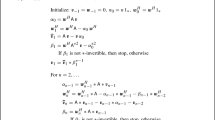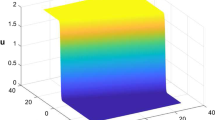Abstract
Based on the invariant subspace method, a symbolic computation scheme and its corresponding MAPLE package are developed to construct exact solutions for nonlinear evolution equations. In the symbolic computation scheme, a crucial step is constructing the linear differential equations as invariant subspaces that systems of evolution equations admin and taking their solutions as subspaces to construct exact solutions. The MAPLE package is proved to provide an easy way for constructing exact solutions of evolution equations automatically by only inputting several necessary parameters. Three different types of examples are given to illustrate the scope and demonstrate the validity of our package, especially for wave equation. The results of the examples reveal that there are polynomial subspaces, trigonometric subspaces, exponential subspaces and other complex subspaces as invariant subspaces that evolutions equations admit. In addition, our MAPLE software package provides a helpful and easy-to-use tool in science and engineering to deal with a wide variety of (1+1) dimensional nonlinear evolution equations.

Similar content being viewed by others
References
Abbasbandy, S.: Solitary wave solutions to the KuramotoSivashinsky equation by means of the homotopy analysis method. Nonlinear Dyn. 52, 35–40 (2008)
Fan, E.: Extended tanh-function method and its applications to nonlinear equations. Phys. Lett. A 277(45), 212–218 (2000)
Fan, E., Zhang, H.: Bäcklund transformation and exact solutions for Whitham-Broer-Kaup equations in shallow water. Appl. Math. Mech. 19, 713–716 (1998)
Galaktionov, V., Svirshchevskii, S.: Exact Solutions and Invariant Subspaces of Nonlinear Partial Differential Equations in Mechanics and Physics. Chapman & Hall/CRC, London (2007)
Harrison, B.K.: Bäcklund transformation for the ernst equation of general relativity. Phys. Rev. Lett. 41, 1197–1200 (1978)
He, J., Wu, X.: Exp-function method for nonlinear wave equations. Chaos Solitons Fractals 30(3), 700–708 (2006)
Hirota, R., Grammaticos, B., Ramani, A.: Soliton structure of the Drinfel’d–Sokolov–Wilson equation. J. Math. Phys. 27, 1499–1505 (1986)
Li, Z., Liu, Y.: RAEEM: a maple package for finding a series of exact traveling wave solutions for nonlinear evolution equations. Comput. Phys. Commun. 163, 191–201 (2004)
Ma, W.X.: A refined invariant subspace method and applications to evolution equations. Sci. China Math. 55, 1769–1778 (2012)
Ma, W.X., Huang, T., Zhang, Y.: A multiple exp-function method for nonlinear differential equations and its application. Phys. Scr. 82(065), 003 (2010)
Ma, W.X., Liu, Y.: Invariant subspaces and exact solutions of a class of dispersive evolution equations. Commun. Nonlinear Sci. Numer. Simul. 17(10), 3795–3801 (2012)
Malfliet, W.: The tanh method: a tool for solving certain classes of nonlinear evolution and wave equations. J. Comput. Appl. Math. 164–165(0), 529–541 (2004)
Misirli, E., Gurefe, Y.: Exact solutions of the Drinfeld–Sokolov–Wilson equation using the Exp-function method. Appl. Math. Comput. 216(9), 2623–2627 (2010)
Olver, P.: Applications of Lie Groups to Differential Equations. Springer, New York (2000)
Parkes, E., Duffy, B.: An automated tanh-function method for finding solitary wave solutions to non-linear evolution equations. Comput. Phys. Commun. 98(3), 288–300 (1996)
Qu, C., Zhu, C.: Classification of coupled systems with two-component nonlinear diffusion equations by the invariant subspace method. J. Phys. A Math. Theor. 42, 475,201 (2009)
Shen, S., Qu, C., Jin, Y., Ji, L.: Maximal dimension of invariant subspaces to systems of nonlinear evolution equations. Chin. Ann. Math. Ser. B 33(2), 161–178 (2012)
Svirshchevskii, S.: Invariant linear spaces and exact solutions of nonlinear evolution equations. J. Nonlinear Math. Phys. 3, 164–169 (1996)
Wang, Y., Tian, B., Wang, P., Li, M., Jiang, Y.: Bell-polynomial approach and soliton solutions for the Zhiber–Shabat equation and (2+1)-dimensional Gardner equation with symbolic computation. Nonlinear Dyn. 69, 2031–2040 (2012)
Wazwaz, A.M.: The tanh method for traveling wave solutions of nonlinear equations. Appl. Math. Comput. 154(3), 713–723 (2004)
Yao, R., Li, Z.: New exact solutions for three nonlinear evolution equations. Phys. Lett. A 297(34), 196–204 (2002)
Yao, Y.: Abundant families of new traveling wave solutions for the coupled Drinfel’d–Sokolov–Wilson equation. Chaos Solitons Fractals 24(1), 301–307 (2005)
Zhao, X., Zhao, H.: An improved F-Expansion method and its application to coupled Drinfel’d–Sokolov–Wilson equation. Commun. Theor. Phys. 50, 309–314 (2008)
Zhu, C., Qu, C.: Maximal dimension of invariant subspaces admitted by nonlinear vector differential operators. J. Math. Phys. 52, 043,507 (2011)
Author information
Authors and Affiliations
Corresponding author
Appendix: The usage of the software package ISM
Appendix: The usage of the software package ISM
The main interface is \(Isolve(Eqs, var, dim)\), where the parameter \(Eqs\) is a set of nonlinear evolution equations, \(var\) represents the independent variable appearing in the invariant subspaces, \(dim\) is the desired order of ordinary differential equations.
As an example to show how to use our software package ISM, we consider a Kuramoto–Sivashinsky equation [1]
To load the package ISM, one can proceed as follows:
-
\(>restart:\) initializing Maple.
-
\(>read \,\,``ISM.mpl'': \) reading the program file into memory.
-
\(>with(ISM); \) loading the package ADMP.
To solve Eq. (75), one can run the main procedure as follows:
-
\(>eq:=diff(u(t,x),t)+a*u*diff(u(t,x),x)+b*diff(u(t,x),x\$2)+k*diff(u(t,x),x\$4)=0;\)
-
\(>Isolve([eq1], x, [2]);\)
Our package automatically outputs the following results:
[1] Obtain the evolution equation(s) is/are
which admits an invariant subspace defined by
The invariant condition is
Then, the exact solutions are listed as follows:
where the coefficients can be determined by the following
Its solution reads
Rights and permissions
About this article
Cite this article
Zhang, L., Lin, Y. Symbolic computation of exact solutions for nonlinear evolution equations. Nonlinear Dyn 79, 823–833 (2015). https://doi.org/10.1007/s11071-014-1705-6
Received:
Accepted:
Published:
Issue Date:
DOI: https://doi.org/10.1007/s11071-014-1705-6




